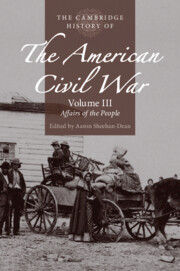Book contents
- The Cambridge History of the American Civil War
- The Cambridge History of the American Civil War
- The Cambridge History of the American Civil War
- Copyright page
- Contents
- Plates
- Figures
- Contributors to Volume III
- Note on the Text
- Part I Values
- Part II Social Experience
- 6 Families in the Civil War
- 7 Refugees and Movement in the Civil War
- 8 Citizen Soldiers
- 9 Immigrant America and the Civil War
- 10 Emancipation and War
- 11 The Black Military Experience
- 12 Motives and Morale
- 13 Urban and Rural America in the Civil War
- Part III Outcomes
- Index
- Plate Section (PDF Only)
- References
9 - Immigrant America and the Civil War
from Part II - Social Experience
Published online by Cambridge University Press: 11 October 2019
- The Cambridge History of the American Civil War
- The Cambridge History of the American Civil War
- The Cambridge History of the American Civil War
- Copyright page
- Contents
- Plates
- Figures
- Contributors to Volume III
- Note on the Text
- Part I Values
- Part II Social Experience
- 6 Families in the Civil War
- 7 Refugees and Movement in the Civil War
- 8 Citizen Soldiers
- 9 Immigrant America and the Civil War
- 10 Emancipation and War
- 11 The Black Military Experience
- 12 Motives and Morale
- 13 Urban and Rural America in the Civil War
- Part III Outcomes
- Index
- Plate Section (PDF Only)
- References
Summary
On April 20, 1861, the New York Irish American, dedicated to telling news about and looking after the interests of the growing Irish population in the United States, acknowledged the news coming from South Carolina about the nascent Confederacy’s firing upon Fort Sumter in Charleston Harbor. Founded and operated by Patrick Lynch, who had left Ireland in 1847, the paper was one of the Irish “community’s leading voices” in the antebellum era. Lynch’s editorial noted that this news would “be read with regret by every true patriot.” The paper had hoped for compromise because war would bring delight to “the despotic governments of the Old World” because the government that was “a perpetual reproach to their own narrow and tyrannical systems” was now self-destructing. They would be able to boast that “the grand experiment of man’s capacity for self-government had come to naught.
- Type
- Chapter
- Information
- The Cambridge History of the American Civil War , pp. 173 - 193Publisher: Cambridge University PressPrint publication year: 2019



